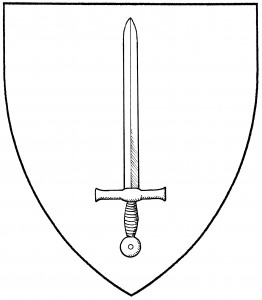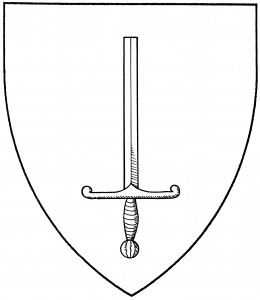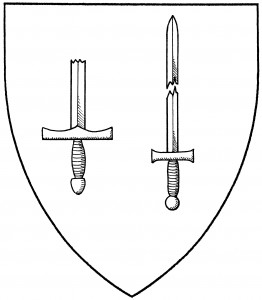A sword is a hand weapon with a long pointed blade, which may be single or double-edged, set in a hilt. It was the primary hand weapon of the Middle Ages; as an heraldic charge it dates from c.1275, in the canting arms of Marmion [ANA2 550]. The default orientation is palewise, point to chief; if the sword is single-edged, the edge is to dexter by default. When blazoned “proper”, the sword has an argent blade and Or quillons and hilt.
There are a great many variant forms of sword, depending on the shape of the blade; many strange forms are blazoned simply as a “sword”. No difference is therefore counted between the variants. The most common form is the “broadsword” or “arming sword”: straight-bladed, double-edged, straight-quilloned. Any sword whose form is unspecified may be safely drawn in this form.
The sword’s blade may be altered in some manner. The oldest such alteration is the “curtana”, or more fully, the “sword curtana”: a sword with its point blunted. The curtana, though not a charge on shields, was part of the English coronation ceremony, where it is also known as the Sword of Mercy. It was certainly in use temp. Richard III, 1483 [OED], and is described by Archbishop Cranmer as used in Edward VI’s coronation, 1547 [Pemberton, The Coronation Service, 1901, p.23].
A more severe alteration is the “broken sword”, with the blade snapped away halfway down its length [Franklyn 321]; it’s found in the crest of Ryvet or Rivett, c.1528 [Woodcock & Robinson pl.13]. This should not be confused with the “sword fracted”, which is a complete sword separated into two fragments, as seen in the arms of Kemp of Thomastoun, 1582 [Dunvegan Armorial, fo.429].
Of swords peculiar to the Society, there are the “sword of Damocles”, a broadsword hanging, point down, from a thread tied to the hilt; and the “sword of Hoflichskeit”, an obsolete Society term for a mullet of four points elongated to base, gyronny Or and sable.
The Society’s other sword variants may be classed according to blade shape: straight-bladed or curved-bladed. The Society permits many variants which, while found as artifacts or weapons in period, were not period heraldic charges.
The straight-bladed swords found in period heraldry (in addition to the standard broadsword) include:
The curved-bladed swords found in period heraldry include:
The straight-bladed swords found as artifacts in period include:
- The claymore
- The gladius
- The great sword
The curved-bladed swords found as artifacts in period include:
Swords which are disallowed in the Society include:
- The saber (modern cavalry saber)
For related charges, see knife, zulfikar. See also scabbard.
The Marshallate bears: Sable, two swords in saltire Or.
Peter of Stratford bears: Or, chapé checky argent and sable, a sword sable.
Donnabhán O Rothláin bears: Vert, three pairs of swords in saltire Or.
El of the Two Knives bears: Sable, two swords Curtana inverted and conjoined at the quillons within a bordure Or.
Ivan Piotrovic Pevcov bears: Per fess indented argent and gules, a broken sword bendwise proper.
Lothar of Rothenborg bears: Or, a sword fracted sable hilted gules, between two flaunches azure.
Roger von Allenstein bears: Gules, on a pile sable fimbriated argent the sword of Damocles pendant Or.


